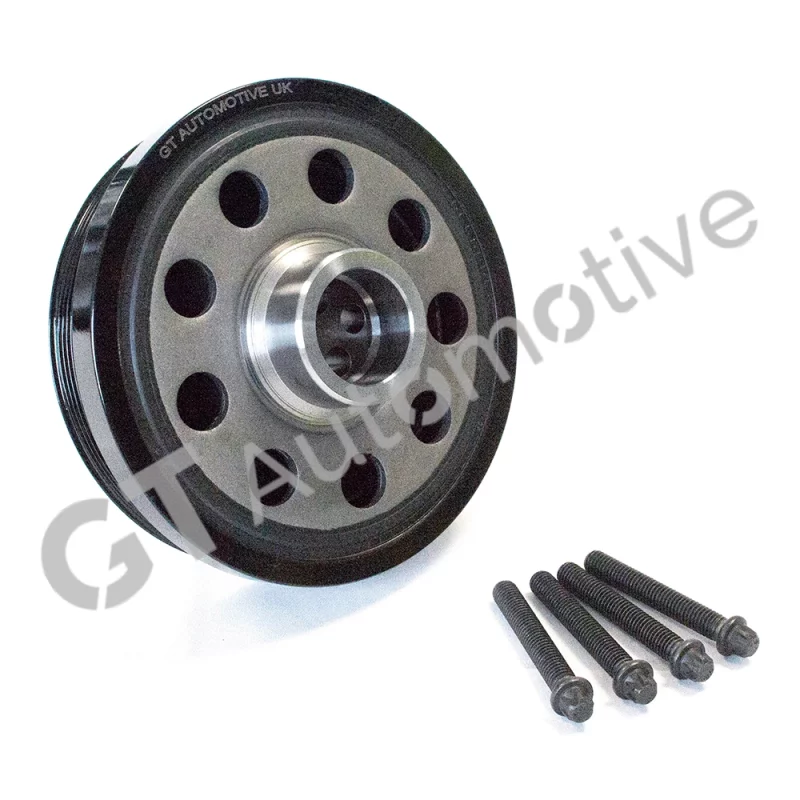Crankshaft Pulley Failure – The Crucial Service Part that Shouldn’t be Ignored
What is a Crankshaft Pulley?
The crankshaft pulley, also known as a torsional vibration damper (TVD) or harmonic damper pulley, is an integral component crucial for engine operation and performance. The crankshaft pulley acts as a link between the crankshaft, which controls the movement of the pistons, and various other components including the camshaft, water pump and alternator.

Additonally, the pulley features a layer of damping rubber preventing any excessive vibration passing through to the rest of the engine components, which would otherwise cause constant premature wear and eventually engine failure.
Symptoms of a Failing Crankshaft Pulley
- Excessive Vibration – If the rubber in the TVD starts to fail the pulley will be unable to dampen the vibrations from the engine. This excessive vibration will have a negative effect on the engine and various components
- Damaged or Misaligned Drive Belt – A damaged crankshaft pulley can have an adverse effect on the belt. This is usually a result of excessive vibration which causes the belt to change position
- Illuminated Battery Light – As the crankshaft pulley also powers the alternator, if there are any faults it may not charge the battery effectively, causing it to lose charge
- Slapping or Tapping Noises – When the crankshaft pulley and timing belt aren’t operating properly you may hear a tapping or slapping noise from the engine
What Causes Crankshaft Pulley Failure?
The pulley should last the lifetime of the engine. They’re designed to be robust and resilient due to their vital role. However, there are a few factors that can contribute to the failure of this part.
The vibration damping rubber can wear over time when exposed to any fluid, such as oil or coolant. It’s important to make sure that the vehicle is serviced regularly to ensure that no leaking occurs which can contaminate the rubber, as this can cause the pulley to separate into two pieces and become completely non-operational.

Improper installation, the use of low quality parts and excessive belt tension are common causes of a faulty pulley.
When Should it be Changed?
As soon as any of the symptoms listed above are noticed it is imperative to have the pulley checked as soon as possible. The worst case scenario is that it fails while in operation, disrupting the timing and causing the engine valves to collide with the pistons. When this happens this can cause total engine failure and it will be extremely costly to have the engine repaired or replaced.
Even if it does not immediately lead to engine failure, the excessive vibrations that come from a faulty pulley can cause damage to the other components in the engine.
Do the Bolts need to be Replaced?
It is also very important to note that the stretch bolts, if a crankshaft pulley is fitted with them, will also need replacing at the time of service or replacement.
Stretch bolts, by their name, are “stretchy” and expand and contract under the enormous pressure of a working engine, like the motion of a spring. The combination of this unique nature and having been manufactured from high tensile steel means that they are able to vastly outperform standard mechanical bolts which simply could not cope under the strain.
However, it is due to their nature that they need to be replaced. As they expand and contract, exactly as they are meant to, they can become warped or misshapen and applying these bolts back onto an engine can lead to premature wear to the crankshaft pulley or even bolt shearing. With reuse of these bolts, they can become loose over time and will eventually shear under load.
GT Automotive Crankshaft Pulleys
At GT Automotive, we are market leaders in vibration control including crankshaft pulleys. Our ever expanding range covers the most relevant applications and we work closely with our product development team to ensure that each part matches or exceeds OE quality. When necessary, our pulleys also come as kits including the bolts.
The Essential Range of GT Automotive Crankshaft Pulleys






